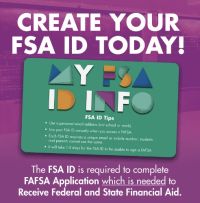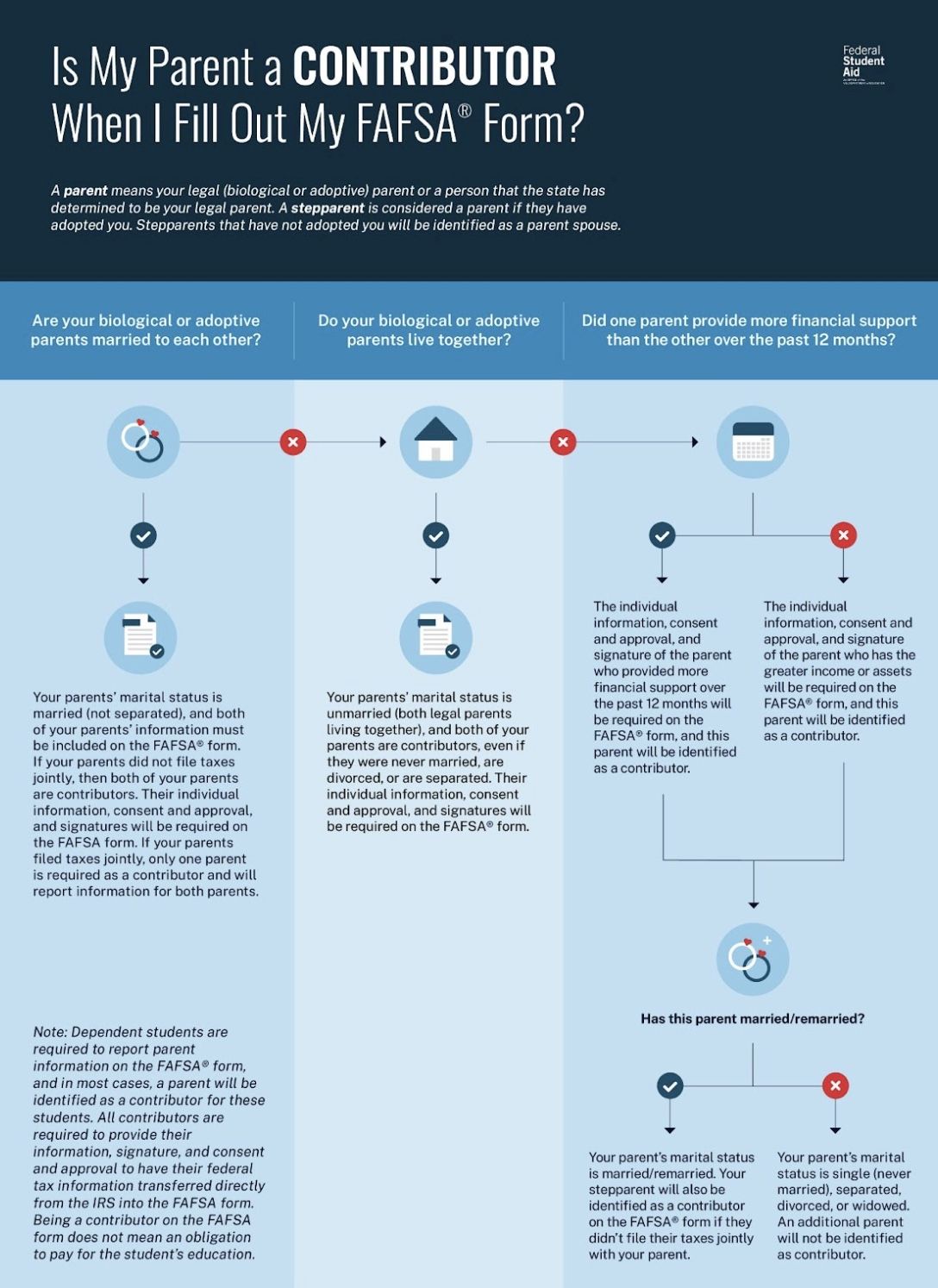Funding College - FAFSA

The 2024-2025 FAFSA is open and provides funding for Fall 2024, Spring 2025, and Summer 2025.
The Free Application for Federal Student Aid, or FAFSA, is the first step in funding college or graduate school. In just two easy steps and entirely online, you can access federal Pell Grant dollars up to $7,395, work study, and student loan options to help fund your college plans. You will need to reapply to the FAFSA each year that you are in college.
Up-To-Date FAFSA Issues & Suggested Workarounds
Here is a brief summary of the issues that have workarounds:
1. If a student incorrectly selects “eligible noncitizen” and completes the demographic section, they will not be able to submit FAFSA after correcting their citizenship status.
- Workaround: Delete current application and start a new one.
2. Parents who need to re-enter a saved FAFSA will need to add country again to submit.
- Workaround: Answer country question again.
3. Student or parent who returns to signed and saved FAFSA that still requires contributors will find the FAFSA no longer has their signature.
- Workaround: Re-sign the FAFSA
4. College names are truncated and difficult to distinguish between when colleges have multiple programs.
- Workaround: Search by federal school code (can be found here).
5. Parent or spouse contributors without FSA IDs are prevented from creating accounts while Social Security Administration (SSA) match is pending.
- Workaround: Delete mailing address on the Create an Account page or waiting until the SSA match is complete.
Perhaps more important are the issues for which there are currently no solutions. The student and contributor are being advised that nothing can be done until FSA gets the system fixed. Here is that list:
- Students without SSNs that exit FAFSA form before “State of Legal Residency” question will be unable to continue or start new form.
- Parent with no SSN is unable to start FAFSA form for student or contribute to an existing form, even if the students starts the application.
- Parent with foreign legal residence is unable to submit FAFSA when they have not filed taxes due to earning no income.
- FAFSA is unable to be submitted if parent contributor “Income Tax Paid” is greater than “AGI” when completing manual income/tax entry.
- A married student or parent who does not provide spouse’s info before leaving the FAFSA will not be able to complete and submit after returning to the form.
FAFSA Updates
The 2024-25 Free Application for Federal Student Aid (FAFSA) is now available. Delays and website issues when working on the form are to be expected throughout January. There are several significant changes to this year’s form. Some of the key changes to the form include:
- Redesigned and simplified form — The FAFSA has undergone a redesign, resulting in a simplified application process.
- Reduced number of questions — Previously consisting of over 100 questions, the revised FAFSA now requires students to answer as few as 18 questions.
- Introduction of Student Aid Index (SAI) — The Expected Family Contribution (EFC) is replaced by the Student Aid Index (SAI), a new formula for determining aid eligibility. Students may now have a negative SAI, with a minimum of -1500.
- Expanded Pell Eligibility — The new FAFSA formula extends Pell Grant eligibility to an additional 610,000 students from low-income backgrounds. Furthermore, 1.5 million students will now qualify for the maximum Pell award, currently set at $7,395 per year.
- More colleges can be added — Students may now add up to 20 colleges on the form.
- Individual FSA IDs for contributors — Each contributor, including the student, spouse, biological or adoptive parent, or parent's spouse (depending on tax filing status), must have a unique Federal Student Aid (FSA) ID to log in and complete their section of the form. The FSA ID request process may take up to three days.
- Direct IRS data import — All contributors must agree to allow the IRS to directly import their federal tax information to the FAFSA. This streamlined data exchange simplifies the form completion process by eliminating the need for manual entry of tax information.
- Parents Without SSN can create an FSA ID — Parents without a Social Security Number (SSN) will be able to create an FSA ID when the FAFSA launches, ensuring broader accessibility.
These changes aim to enhance the FAFSA experience, making it more user-friendly, inclusive, and efficient for students and their families.
Delayed Processing of the FAFSA
- Colleges will not receive data on any submitted FAFSAs until the firstr half of March, 2024. Therefore, students and families will not be able to have any detailed discussion with a financial aid office about the submitted FAFSA until after the college receives the data.
- After a FAFSA is submitted, students will receive a confirmation email and access to a confirmation page with their estimated Student Aid Index, or SAI, (replacement for EFC) and estimated federal aid eligibility. We strongly recommend that you encourage students to print a copy of the confirmation screen for their records and to have some sense of their financial need.
- Students will not receive their FAFSA Submission Summary (new name for the Student Aid Report) until the end of January. As such, students will not be able to go in and add colleges or make any corrections until they receive that document.
- State agencies will also not receive information on processed FAFSAs until the end of January. The state will therefore be delayed in providing student level data reports for which students have completed the FAFSA. These reports will likely not become available until mid-to-late February.
- With colleges not receiving FAFSA data until mid-March, they will need time to fully test their systems. This process may take weeks. Therefore, it is expected that students will not begin to receive aid offers until mid-April.
Institutional Need-Based Aid Timeline
Students can expect to receive their institutional need-based aid offerings in late Spring (April/May). These monies are awarded to students who demonstrate the need for financial assistance in paying for college. Award amounts are based on the information provided to a college or university within a student’s FAFSA form. This information must be processed by a college or university before an award is offered.
Free Spring Training Tickets
Exciting news! We're delighted to announce our second-year partnership with the Arizona Cactus League to boost FAFSA engagement for the high school class of 2024.
The first 750 Arizona high school seniors who complete the FAFSA and submit a spring training submission form will receive four tickets to attend a spring training game this season – a fantastic home run for all! This promotion kicks off on January 8, with FAFSA submissions accepted before that date. Spread the word about this fun and exciting FAFSA incentive, and help your seniors score tickets to a memorable spring training experience!
The Pell Grant is money provided by the federal government to help pay for college. The Federal Student Aid Estimator provides an estimate what federal student aid you may be eligible for. Additionally, these tables provide an estimate of how many Pell dollars you may be eligible to receive. Check out the NCAC article Breaking Down the 2024-25 Pell Look-Up Tables (Vallejo, 2023) for more information.

-
Step 1:
Create an FSA ID. BOTH you as the student and your “contributor(s)” need to create an FSA ID.
Who is a “contributor”? One or both of your parents/guardians or your spouse. Follow the chart below to see which parent(s) to include. If you are an independent student, your application will not include contributors.

Contributors without a Social Security Number can now create an FSA ID through identity verification and will take place through the FSA portal.
-
Step 2:
Complete the FAFSA form. Both the student and their contributor(s) will need to complete their portions of the form, which include separate sets of required questions.
Students that are not eligible to complete the FAFSA form
Students without a Social Security Number cannot complete the FAFSA form.
Many schools, including the UArizona, Arizona State University, and Northern Arizona University, will accept the College Board CSS Profile instead of the FAFSA to determine eligibility for need-based institutional financial aid. Check out the 24-25 list of participating schools and institutions.
UArizona CSS code: 4832
Arizona State University CSS code: 4007
Northern Arizona University CSS code: 4006
